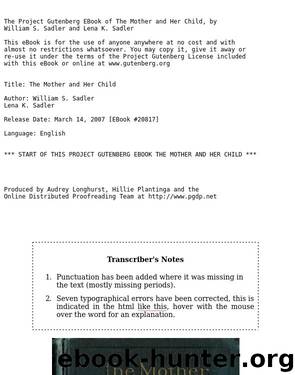The Mother and Her Child by Lena K. Sadler & William S. Sadler

Author:Lena K. Sadler & William S. Sadler [Sadler, Lena K. & Sadler, William S.]
Language: eng
Format: epub
Tags: Medical, Health Care Delivery, Womanhood And Happiness, Child care, Children -- Health and hygiene, Women
ISBN: 9781406589214
Google: 8HSeMAAACAAJ
Amazon: 1406589217
Publisher: Dodo Press
Published: 2008-02-14T18:30:00+00:00
DENTITION
In both the upper and lower jawbones of the newborn infant there are hidden away in snug little cavities two sets of tiny teeth; the first set, or milk teeth, and the second set, or permanent teeth. These rudimentary teeth grow as the baby grows and push their way up or down from the jawbones until they finally make their appearance through the gums. The milk teeth appear in a definite way and in five definite groups.
There should be no physical disturbance at the appearance of the teeth, which is a physiological process, and it is to be deplored that all of the ills of babyhood are laid upon the teeth with the careless remark: "Oh, its his teeth!" Many, many illnesses are neglected because our inexperienced mother has been told that she can expect "anything to happen when the baby is cutting its teeth." Now, it is true that the babies of many families do have trouble in cutting their teeth, but the majority of babies cut their teeth comfortably and the first knowledge anyone has of it is the appearance of the tooth itself. As the teeth push their way nearer the surface of the gums, there is a broadening and a hardening of the gums themselves, and it is the exception rather than the rule that the baby needs any help in cutting his teeth.
Usually by the time the baby is seven months old it has two central teeth on the lower jaw (the central incisors), which constitute the first group. The second group of teeth to appear is the four upper central teeth which are all through by the time the baby is twelve months old, and are often through at ten months. Then there is a pause of from one to three months before the next teeth appear—the four anterior molars. As these four anterior molars come in, the two lateral incisors appear on the lower jaw, which now gives us, by the time the baby is fourteen or fifteen months old, four central teeth upper, four central teeth lower, and the four anterior molars, which make twelve teeth.
Another pause of two or three months and then we get the four canine, which fill in the space between the first molars and the front teeth. The canine on the upper jaw are commonly known as the eye teeth, while the canine teeth on the lower jaw are spoken of as the stomach teeth. This brings us to the age of eighteen to twenty-four months, when there is still another pause of two or three months, after which time the big teeth or the four posterior molars appear, which completes the first set of twenty teeth—the milk teeth. When baby is twenty months old the milk teeth are often all in. The complete set should appear not later than the thirtieth month.
During the life of the milk teeth the child should be taken to the dentist at least once a year, better once in six months, for all defective teeth must be properly and promptly cared for.
Download
This site does not store any files on its server. We only index and link to content provided by other sites. Please contact the content providers to delete copyright contents if any and email us, we'll remove relevant links or contents immediately.
Should I Stay or Should I Go? by Ramani Durvasula(7562)
The Lost Art of Listening by Michael P. Nichols(7406)
The Rosie Project by Graeme Simsion(6189)
Beartown by Fredrik Backman(5598)
We Need to Talk by Celeste Headlee(5542)
Ego Is the Enemy by Ryan Holiday(5294)
Hunger by Roxane Gay(4869)
Suicide Notes by Michael Thomas Ford(4764)
I Love You But I Don't Trust You by Mira Kirshenbaum(3806)
Mummy Knew by Lisa James(3632)
Not a Diet Book by James Smith(3336)
Crazy Is My Superpower by A.J. Mendez Brooks(3329)
Toxic Parents by Susan Forward(3219)
Girl, Wash Your Face by Rachel Hollis(3210)
The Complete Idiot's Guide to Coping With Difficult People by Arlene Uhl(3116)
The Social Psychology of Inequality by Unknown(2940)
Name Book, The: Over 10,000 Names--Their Meanings, Origins, and Spiritual Significance by Astoria Dorothy(2939)
The Hard Questions by Susan Piver(2925)
The Gaslight Effect by Dr. Robin Stern(2736)
